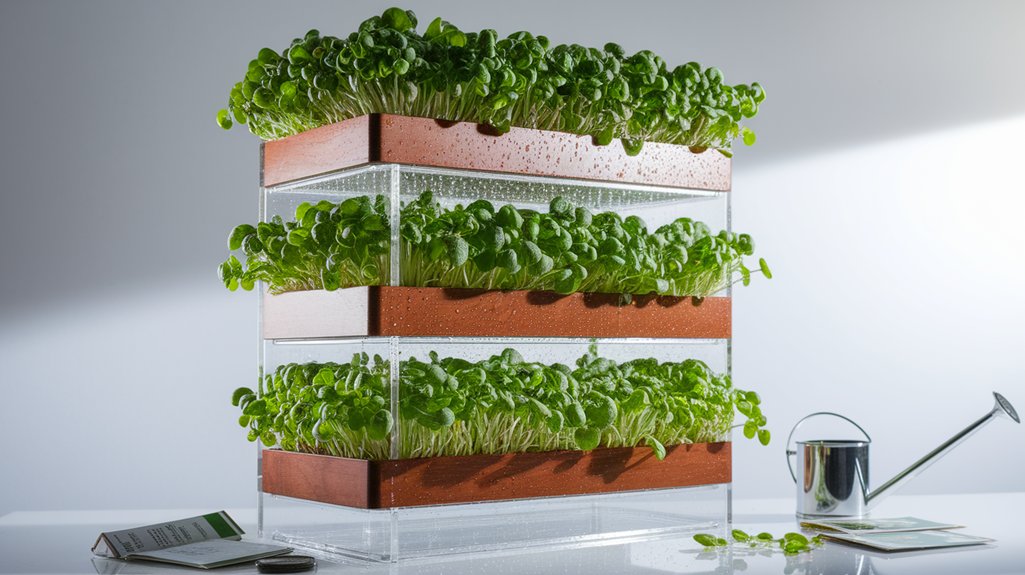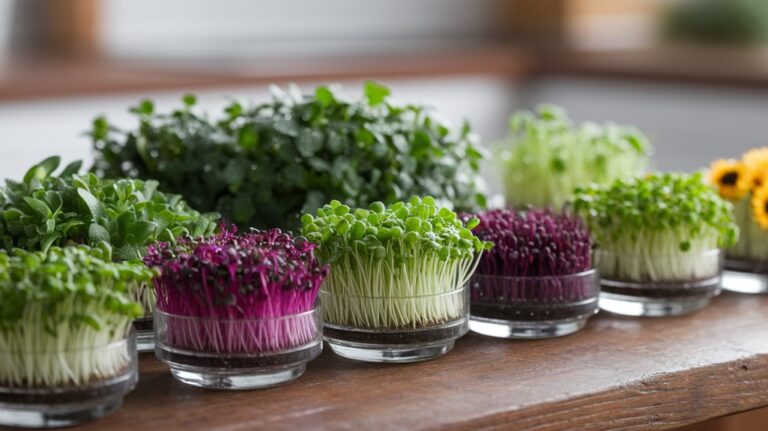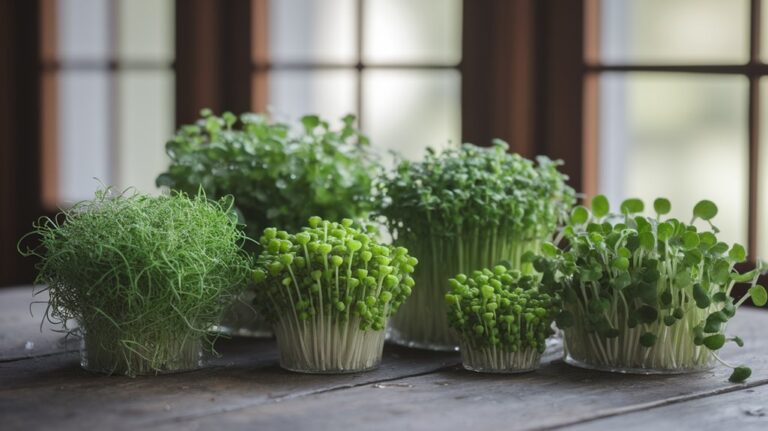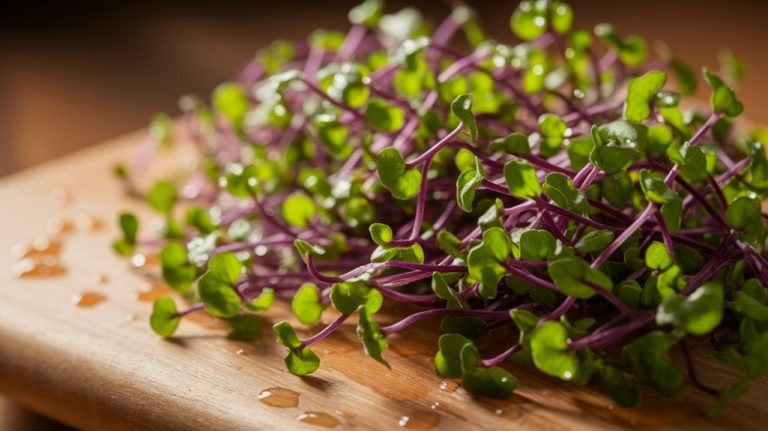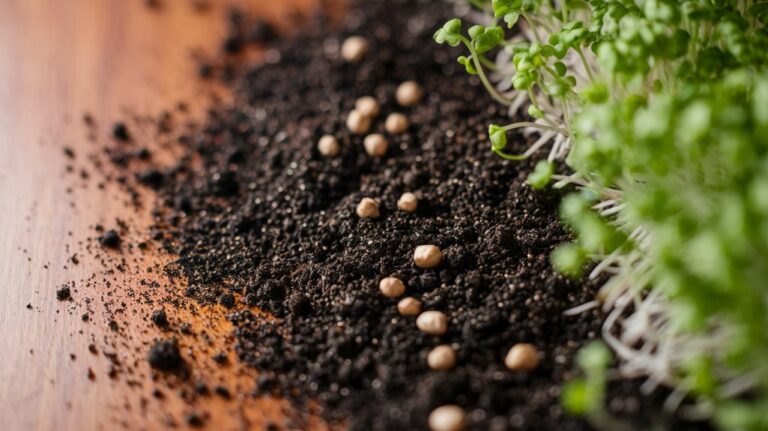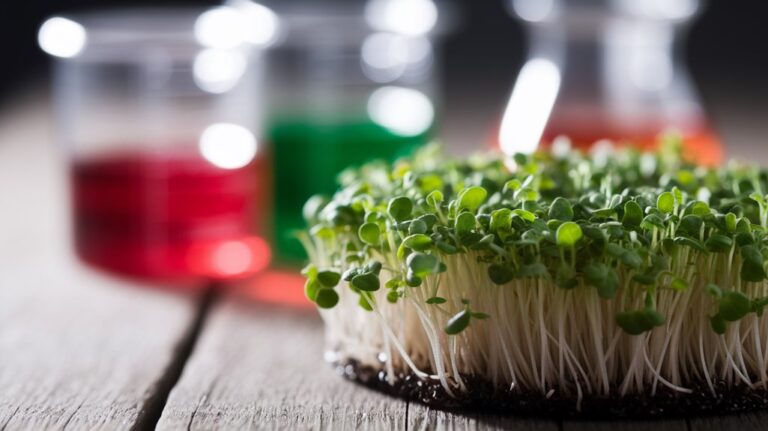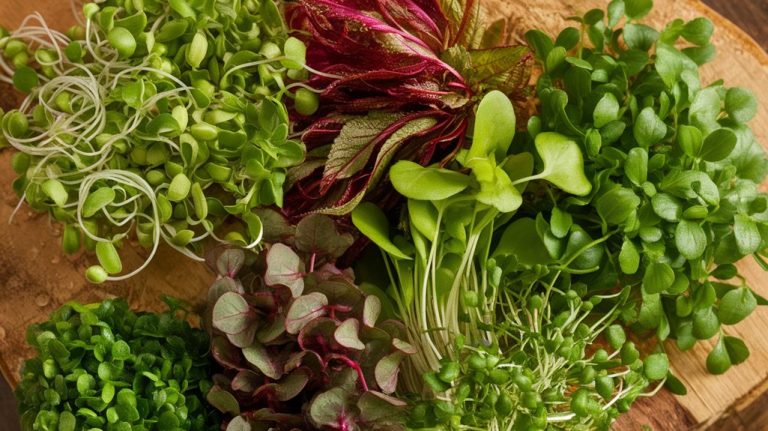DIY Vertical Microgreen Tower: Step‑by‑Step Build
To build your DIY vertical microgreen tower, start by gathering high-quality materials like PVC pipes, a seed-starting mix, and a watering system. Cut pipes to your preferred height and drill holes for planting. Assemble the tower with T-joints for support and incorporate a drip line for hydration. Plant your seeds evenly, maintain moisture, and ensure proper light and temperature conditions. As you care for your tower, you’ll discover essential harvesting and maintenance tips along the way.
Key Takeaways
- Gather essential materials, including PVC pipes, a high-quality seed-starting mix, and tools like a drill and saw for construction.
- Cut the PVC pipes to your desired height and drill evenly spaced holes for planting microgreens.
- Connect the pipes using T-joints for stability and attach a drip irrigation system to ensure even watering.
- Plant seeds evenly in the holes, cover lightly with soil, and label each variety for easy identification.
- Maintain proper watering, humidity, and nutrient levels, monitoring growth until microgreens are ready for harvesting in 7 to 14 days.
Understanding Microgreens: Benefits and Varieties
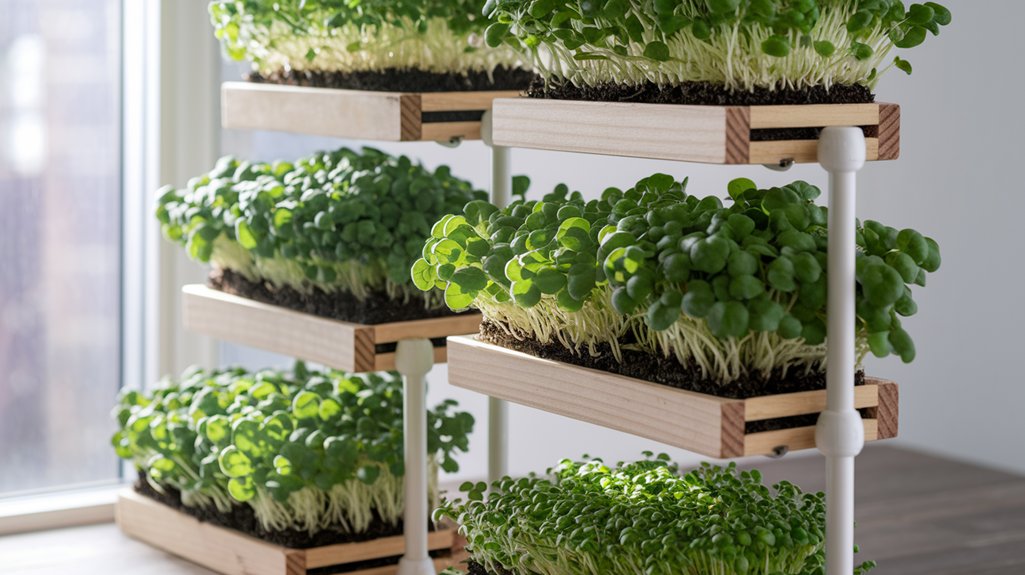
As I delve into the world of microgreens, it’s clear that these tiny, nutrient-dense plants offer a remarkable array of benefits and varieties. Packed with vitamins, minerals, and antioxidants, microgreens can enhance any diet.
For instance, broccoli microgreens are known for their high sulforaphane content, which may support detoxification. On the other hand, radish microgreens deliver a spicy kick along with notable levels of vitamin C.
I’ve found that growing a mix of varieties like basil, kale, and arugula not only adds flavor but also maximizes nutritional diversity. Each microgreen has its unique taste profile and health benefits, making them versatile additions to salads, sandwiches, and smoothies.
Understanding these factors can significantly elevate your culinary creations.
Selecting the Right Location for Your Tower
Choosing the right location for your vertical microgreen tower is crucial for successful growth.
I’ve found that the environment can significantly impact your microgreens’ health and yield. Here are some key factors to consider when selecting the perfect spot:
- Light Exposure: Ensure your tower receives at least 12-16 hours of bright, indirect light daily.
- Temperature: Maintain a consistent temperature between 65°F and 75°F for optimal germination.
- Humidity: A humid environment (around 50-70%) encourages healthy growth.
- Air Circulation: Good airflow helps prevent mold and disease.
- Accessibility: Choose a location that’s convenient for daily maintenance and harvesting.
Materials Needed for Your Vertical Microgreen Tower
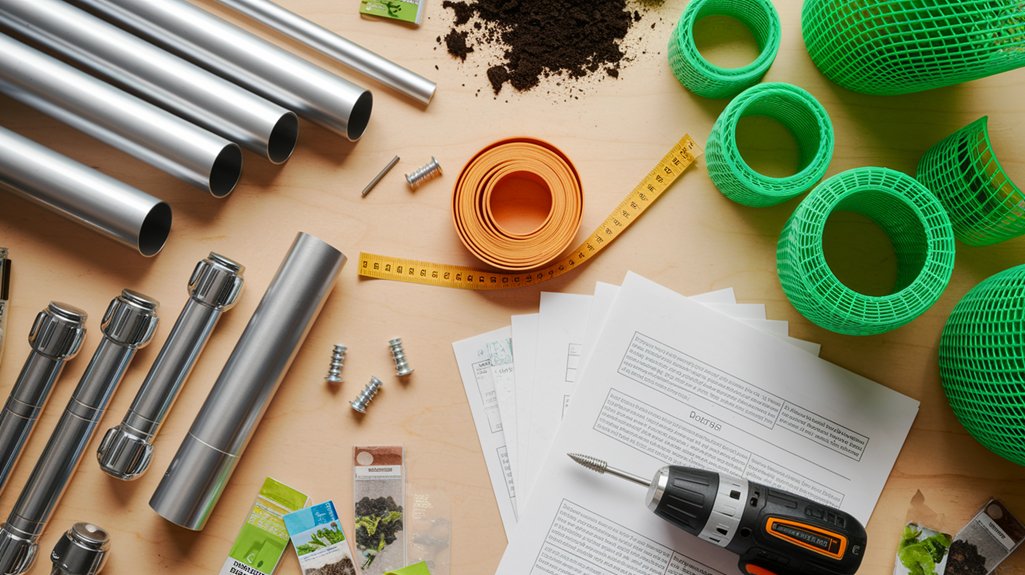
To build your vertical microgreen tower, you’ll need a few essential tools, including a drill, measuring tape, and a sturdy base.
Choosing the right soil is crucial for optimal growth, so I recommend looking for a high-quality seed-starting mix that provides good drainage and nutrients.
Let’s explore these materials in detail to ensure your microgreens flourish.
Essential Tools Required
While I’ve found that building a vertical microgreen tower can be a rewarding project, having the right materials on hand is crucial for success.
Here’s a list of essential tools I recommend for your build:
- Drill: For creating holes in the tower structure.
- Saw: A handsaw or circular saw will help cut wood or PVC pipes to size.
- Screwdriver: Necessary for assembling components with screws.
- Measuring Tape: Ensures precise measurements for uniformity.
- Level: To make sure your tower stands straight and stable.
These tools will simplify the building process and ensure your microgreen tower is sturdy and efficient.
With the right equipment, you’ll be well on your way to growing delicious microgreens!
Best Soil Options
Selecting the right soil for your vertical microgreen tower is vital for optimal growth and health of your plants.
I recommend using a high-quality, lightweight soil mix specifically formulated for microgreens. Look for a blend that contains peat moss, coconut coir, and perlite. This combination ensures proper aeration and drainage, preventing waterlogging while retaining moisture.
Additionally, consider adding worm castings or compost to enrich the soil with essential nutrients.
Avoid heavy garden soils, as they can compact and hinder root development. It’s also important to ensure your soil is sterile to prevent diseases.
By choosing the right soil, you’ll set a solid foundation for your microgreens, allowing them to flourish in your vertical tower.
Happy growing!
Designing Your Tower: Dimensions and Layout
When designing your vertical microgreen tower, understanding the dimensions and layout is crucial for maximizing space and plant health.
I’ve found that careful consideration of height, width, and spacing leads to better yields. Here are some key factors to keep in mind:
- Height: Aim for 4-6 feet for optimal light exposure.
- Width: Ensure a base of at least 2 feet for stability.
- Tray Size: Use trays that are 10-12 inches wide to accommodate various microgreens.
- Spacing: Allow 1-2 inches between trays for air circulation.
- Light Source: Position your tower near natural light or supplemental grow lights.
Building the Structure: Step-by-Step Instructions
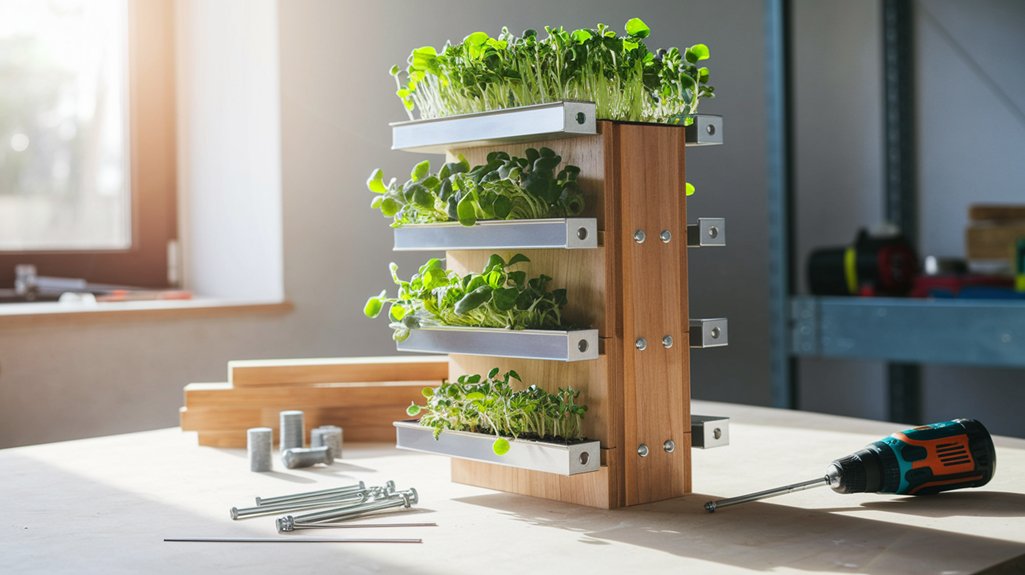
Now that we’ve covered the design aspects of the vertical microgreen tower, let’s get into the practical side of building it.
I’ll share tips on selecting the right materials, outline effective assembly techniques, and discuss important design considerations to ensure your tower functions optimally.
Material Selection Tips
Choosing the right materials is crucial for building an effective vertical microgreen tower. I’ve found that selecting durable and suitable components can greatly influence the success of your microgreens.
Here are some key materials to consider:
- PVC Pipes: Lightweight, easy to cut, and resistant to moisture.
- Net Pots: Allow for drainage and air circulation, promoting healthy root growth.
- Growing Medium: Opt for a soil-less mix or coconut coir for optimal moisture retention.
- Water Reservoir: A sturdy container that holds water to keep your greens hydrated.
- LED Grow Lights: Essential for providing the right light spectrum for photosynthesis.
Assembly Techniques Explained
With the materials selected, assembling your vertical microgreen tower is the next step.
Begin by cutting the PVC pipes to your desired height. I recommend using a saw for precision.
Next, drill evenly spaced holes along the sides of the pipes for planting. Ensure these holes are about 2 inches apart for optimal growth.
After that, connect the pipes using T-joints at the base, creating a stable structure. Secure the joints with PVC cement for added strength.
Once the frame is assembled, attach the watering system, which could be a simple drip line.
Finally, test the system to ensure water flows evenly to each level. Your tower is now ready for planting microgreens.
Design Considerations Overview
As I dive into the design considerations for your vertical microgreen tower, it’s essential to focus on several key factors that will influence both functionality and aesthetics.
Here are some critical elements to keep in mind:
- Material Selection: Choose durable, weather-resistant materials for longevity.
- Size and Height: Determine the tower’s dimensions based on available space and desired yield.
- Water Drainage: Ensure proper drainage to prevent root rot and promote healthy growth.
- Light Exposure: Consider the placement to maximize sunlight or plan for supplemental grow lights.
- Accessibility: Design for easy access to all levels for planting, maintenance, and harvesting.
These considerations will help you create an efficient and visually appealing microgreen tower that meets your gardening goals.
Preparing the Growing Medium for Microgreens
While you might think that any soil will do for growing microgreens, the right growing medium is crucial for ensuring healthy, vibrant plants.
I prefer a light, well-draining mix that retains moisture without becoming waterlogged. A blend of peat moss, coconut coir, and vermiculite works wonders. Peat moss provides aeration, while coconut coir enhances water retention. Vermiculite adds essential nutrients and improves drainage, preventing root rot.
Before using the mix, I sterilize it by baking at 180°F for about 30 minutes to eliminate pathogens. I also ensure the pH level is between 6.0 and 7.0 for optimal nutrient absorption.
Once prepared, I fill my tower trays with about an inch of this mix, ready for planting.
Planting Seeds: Tips for Success
After preparing the growing medium, it’s time to focus on planting seeds effectively.
To ensure success, I’ve found a few tips that help maximize germination and growth:
- Choose high-quality seeds: Always use fresh, organic seeds for better yields.
- Sow evenly: Distribute seeds uniformly to avoid overcrowding, which can lead to competition.
- Follow depth guidelines: Plant seeds at the recommended depth; generally, small seeds need to be sown shallowly.
- Lightly cover seeds: Use a fine layer of growing medium to cover the seeds, ensuring they’re not too deep.
- Label your trays: Mark each type of seed for easy identification as they grow.
Watering and Maintenance of Your Microgreen Tower
When it comes to maintaining my microgreen tower, I’ve learned that a consistent watering schedule is crucial for optimal growth.
I also focus on providing the right nutrients and developing effective pest management strategies to keep my greens healthy.
Let’s explore how to establish these essential practices for a thriving vertical garden.
Watering Schedule Essentials
Establishing a consistent watering schedule is crucial for the health and growth of your vertical microgreen tower. I’ve found that keeping track of moisture levels helps prevent over- or under-watering.
Here are some essentials I follow:
- Frequency: Water every 2-3 days, adjusting based on humidity.
- Time of Day: Water in the morning to allow for even absorption.
- Technique: Use a spray bottle for gentle watering, avoiding soil displacement.
- Drainage: Ensure proper drainage to prevent root rot; excess water should flow out.
- Observation: Regularly check the soil moisture with your finger; it should feel slightly damp.
Sticking to this schedule helps maximize growth and ensures vibrant, healthy microgreens.
Nutrient Requirements for Growth
To ensure your microgreens thrive, understanding their nutrient requirements is essential for both watering and maintenance.
I always start with a quality growing medium, rich in organic matter and nutrients. A balanced nutrient solution, typically a diluted liquid fertilizer, is crucial during their growth phase. I mix in a 20-20-20 NPK fertilizer at half strength once my microgreens establish their first true leaves.
Watering plays a vital role in nutrient uptake; I ensure the growing medium remains consistently moist but not soggy. Additionally, I monitor pH levels, aiming for a range between 6.0 and 7.0 to optimize nutrient absorption.
Regularly checking for any deficiencies helps me adjust the nutrient solution promptly, ensuring my microgreens get the best start possible.
Pest Management Strategies
While pests can quickly become a challenge in your vertical microgreen tower, implementing effective management strategies is key to maintaining healthy plants.
I’ve found that consistent watering and maintenance practices can significantly minimize pest issues. Here are some strategies I recommend:
- Regular Monitoring: Check your plants daily for any signs of pests.
- Maintain Cleanliness: Keep the tower and surrounding area free of debris and old plant material.
- Natural Predators: Introduce beneficial insects like ladybugs to control pest populations.
- Neem Oil Treatment: Apply neem oil as a preventative measure against common pests.
- Humidity Control: Avoid excessive humidity, which can attract pests, by ensuring proper airflow.
Harvesting Your Microgreens: Timing and Techniques
Once I’ve nurtured my microgreens to their peak, knowing when and how to harvest them becomes crucial for maximizing flavor and nutritional value.
Typically, I wait until they reach about 1.5 to 3 inches tall, usually around 7 to 14 days after germination. At this stage, the leaves are vibrant and tender.
To harvest, I use a sharp pair of scissors or a knife, cutting just above the soil line. This method minimizes damage to the roots, allowing for potential regrowth.
I always harvest in the morning when the moisture content is high, ensuring crispness.
After cutting, I rinse them gently to remove any soil or debris, then dry them thoroughly before storage. This approach keeps my microgreens fresh and flavorful.
Troubleshooting Common Issues in Vertical Gardening
Even though vertical gardening offers an innovative way to maximize space, I often encounter common issues that can hinder my microgreen success.
Addressing these problems promptly is crucial for maintaining a healthy crop. Here are some key issues I’ve faced:
- Insufficient Light: Ensure your microgreens receive 12-16 hours of light daily.
- Overwatering: Monitor moisture levels; soggy soil can lead to root rot.
- Air Circulation: Poor airflow can cause mold; consider adding a fan.
- Nutrient Deficiency: Use a balanced fertilizer to promote growth.
- Pest Infestation: Regularly inspect for pests and take preventive measures.
Frequently Asked Questions
How Long Does It Take for Microgreens to Grow?
Microgreens typically take about 7 to 21 days to grow, depending on the variety.
I’ve noticed that faster-growing types, like radish and mustard, can sprout in just a week, while others, like sunflowers, might take closer to two weeks.
I’ve found that keeping the right moisture and light conditions significantly affects their growth rate.
Can I Use Any Seeds for Microgreens?
Yes, you can use various seeds for microgreens, but not all seeds are suitable.
I’ve had great success with seeds like arugula, radish, and basil. These varieties germinate quickly and offer robust flavors.
However, I avoid larger seeds or those treated with pesticides. It’s essential to choose seeds specifically labeled for microgreens to ensure optimal growth and safety.
Experimenting with different types can lead to exciting flavors in your dishes!
What Is the Best Light Source for Microgreens?
When growing microgreens, I’ve found that LED grow lights work best. They emit the right spectrum of light, promoting healthy growth without overheating my plants.
I usually position the lights 12 to 18 inches above the microgreens and keep them on for about 12 to 16 hours daily.
Fluorescent lights are another option, but they don’t provide the same intensity.
Always monitor the plants for any signs of light stress to adjust as needed.
How Often Should I Fertilize My Microgreens?
I usually fertilize my microgreens once or twice during their growth cycle.
Since they’re typically harvested in 7 to 14 days, I apply a diluted liquid fertilizer around day 5. This ensures they receive essential nutrients without overwhelming them.
I check the moisture levels, too; if they seem dry, I lightly mist them with water.
Can I Grow Microgreens Indoors Year-Round?
Absolutely, you can grow microgreens indoors year-round!
I’ve found that providing adequate light is crucial, so I use grow lights to ensure my microgreens get 12-16 hours of light daily.
Temperature control is also important; I keep my space between 65°F and 75°F.
With proper air circulation and moisture management, I maintain healthy growth throughout the seasons.
Indoor growing not only ensures freshness but also allows me to enjoy my greens anytime!
Conclusion
Building your own vertical microgreen tower can be a rewarding project that maximizes space and yields fresh greens right at home. By following the steps outlined, from selecting materials to proper maintenance, you’ll create a thriving mini-garden. Remember to monitor your plants closely and adjust care as needed. With a little patience and practice, you’ll soon enjoy the benefits of homegrown microgreens, adding both flavor and nutrition to your meals. Happy gardening!

